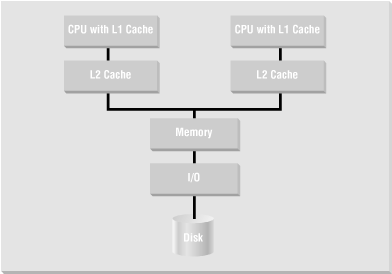Symmetric Multiprocessing Systems
One of the limiting factors for a uniprocessor system is the ultimate speed of its processor—all applications have to share this one resource. Symmetric Multiprocessing (SMP) systems were invented in an effort to overcome this limitation by adding CPUs to the memory bus, as shown in Figure 11-2.

Figure 11-2. Typical Symmetric Multiprocessing (SMP) system
Each CPU has its own memory cache, but data in a cache associated with one CPU might be requested by another CPU. Because of this potential sharing of data, the CPUs for such machines must be able to “snoop” the memory bus to determine where copies of data reside and whether the data is being updated. This snooping is managed transparently by the operating system that controls the SMP system, so standard Oracle releases of Oracle Server and Oracle Enterprise Edition can be used on such platforms.
SMP platforms have been available since the 1980s as midrange platforms, primarily as Unix-based machines. Today, there is a relatively new category of SMP PC servers based on Intel (or Intel instruction set-compatible) CPUs. The most popular operating system in this category is Windows NT/2000, although there are various Unix operating system variations, including SCO Unix and Linux.
Larger and more expensive SMP servers feature variations on this basic design. For example, SMP systems might include Reduced ...
Get Oracle Essentials: Oracle9i, Oracle8i and Oracle8, Second Edition now with the O’Reilly learning platform.
O’Reilly members experience books, live events, courses curated by job role, and more from O’Reilly and nearly 200 top publishers.

